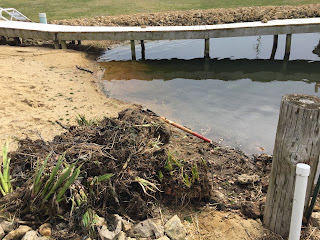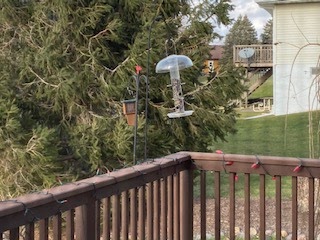How I spent Saturday afternoon
Yellow flag irises on the lake beachside had spread, maybe six or eight feet, and 2-3 feet into the water.
This patch of vigorous, yet glorious perennials had been untended for a decade or more, and it looked that way. So, armed with a small Arsenal of garden tools, and finally, a hand saw, I attacked the space.
We needed to start to eradicate the unwanted plants to add more room to a recreational area, increasingly used by kayakers (mainly, me), pontoon boaters and family members who would like to float on the water this summer. The yellow irises made the beach into a small entry point.
It was the hardest landscape chore I've tackled in the 25 years I've lived on Lake Huntington, located in northern Scott County.
First, I decked out in old pants, socks, and my garden tennis shoes. It was about 60 degrees and cloudy, so I had on multiple jackets as well. These would not be needed very long.
The irises showed about 6 inches of green leaves, but the underground rhizomes stretched long and deep. This plant is now called a noxious weed by the Extension Service in Oregon (extension.oregon.edu) and officials encourage gardeners not to plant it, as it is not native to the United States.
The rhizomes form extensive networks if untended, and that's what I faced. I started my task with a fork-shaped shovel, as well as a shovel that has a long, thin and sharp shape. I used both to pull out the rhizomes, which were enormous. I was shocked, and impressed, by the size of these monsters.
According to the Iowa State Extension Service, there is more work to do in this area. I will have to keep at the eradication process for about 2-3 years in cases like this one.
Why did we plant them in the first place? In those days, the area was frequented by small children who liked to play in the sand and wade in the lake. The iris plants are pretty in the spring and early summer, and they provided a natural barrier to the children.
Now the kids have grown up; the youngest is 13 years old. The irises have to go, and the bonus for us is a cleaned-up area of space, and hopefully, a more physically fit gardener. The next garden task is preparing seven areas for flowers, both perennials and annuals.
This patch of vigorous, yet glorious perennials had been untended for a decade or more, and it looked that way. So, armed with a small Arsenal of garden tools, and finally, a hand saw, I attacked the space.
We needed to start to eradicate the unwanted plants to add more room to a recreational area, increasingly used by kayakers (mainly, me), pontoon boaters and family members who would like to float on the water this summer. The yellow irises made the beach into a small entry point.
It was the hardest landscape chore I've tackled in the 25 years I've lived on Lake Huntington, located in northern Scott County.
First, I decked out in old pants, socks, and my garden tennis shoes. It was about 60 degrees and cloudy, so I had on multiple jackets as well. These would not be needed very long.
The irises showed about 6 inches of green leaves, but the underground rhizomes stretched long and deep. This plant is now called a noxious weed by the Extension Service in Oregon (extension.oregon.edu) and officials encourage gardeners not to plant it, as it is not native to the United States.
The rhizomes form extensive networks if untended, and that's what I faced. I started my task with a fork-shaped shovel, as well as a shovel that has a long, thin and sharp shape. I used both to pull out the rhizomes, which were enormous. I was shocked, and impressed, by the size of these monsters.
According to the Iowa State Extension Service, there is more work to do in this area. I will have to keep at the eradication process for about 2-3 years in cases like this one.
Why did we plant them in the first place? In those days, the area was frequented by small children who liked to play in the sand and wade in the lake. The iris plants are pretty in the spring and early summer, and they provided a natural barrier to the children.
Now the kids have grown up; the youngest is 13 years old. The irises have to go, and the bonus for us is a cleaned-up area of space, and hopefully, a more physically fit gardener. The next garden task is preparing seven areas for flowers, both perennials and annuals.




Comments
Post a Comment